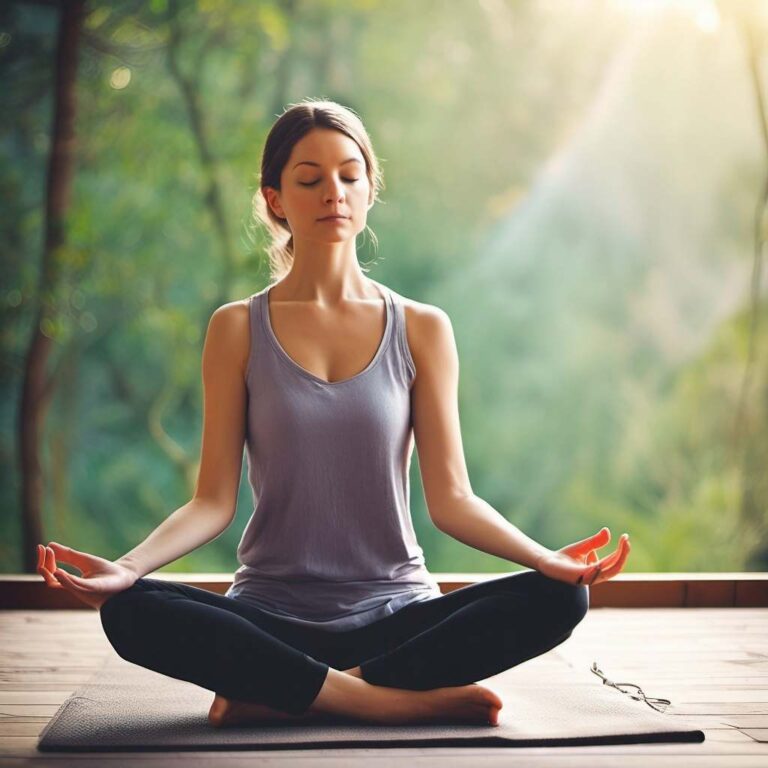Meditation for Anxiety: Alleviate Stress & Find Inner Peace
- Chapter 1: Introduction
- Chapter 2: Understanding Meditation and Its Benefits
- Chapter 3. How Meditation Eases Anxiety
- Chapter 4. Starting a Meditation Practice for Anxiety
- Chapter 5. Frequently Asked Questions (FAQs) about Meditation for Anxiety
- Q1: Can meditation help with both sleep and anxiety?
- Q2: Are there specific meditation techniques for anxiety relief?
- Q3: Are there any reliable resources for anxiety meditation?
- Q4: Can meditation be beneficial for social anxiety?
- Q5: Can meditation be used as a standalone treatment for anxiety disorder?
- Chapter 6: Conclusion
- More Interesting Articles about Meditation

Chapter 1: Introduction
1.1 Overview of Anxiety and Its Impact
Anxiety has become a prevalent issue in today’s society, affecting millions of individuals worldwide. It is characterized by persistent feelings of worry, fear, and apprehension that can significantly impact one’s mental, emotional, and physical well-being.
Mental Impact: Anxiety often leads to racing thoughts, difficulty concentrating, and an inability to relax. It can cause excessive worry about future events or past experiences, leading to a constant state of unease.
Emotional Impact: The emotional toll of anxiety can include increased irritability, restlessness, and a sense of impending doom. Individuals with anxiety may experience heightened emotional responses and struggle with regulating their mood.
Physical Impact: Anxiety can manifest physically through symptoms such as rapid heartbeat, shortness of breath, muscle tension, and headaches. It can also contribute to digestive issues, sleep disturbances, and weakened immune function.
1.2 The Need for Effective Anxiety Management Techniques
Given the significant impact of anxiety on various aspects of life, it is crucial to find effective ways to manage and alleviate these symptoms. While medication and therapy are commonly used treatments, there is a growing recognition of the need for holistic approaches that address the root causes of anxiety.
One such approach gaining popularity is meditation. Meditation is an ancient practice that involves training the mind to focus and redirect thoughts. It offers a range of benefits beyond anxiety relief, including stress reduction, improved emotional well-being, and overall mental clarity.
Meditation allows individuals to cultivate a sense of inner peace and calm, providing a valuable tool for navigating the challenges of anxiety. It offers a space for self-reflection, heightened self-awareness, and the development of skills to manage anxious thoughts and emotions.
In the following chapters, we will explore meditation in-depth and delve into its numerous benefits for anxiety management. By understanding the science behind meditation, exploring mindfulness and self-compassion, learning breathing techniques, and discovering practical tips for starting a meditation practice, you will be equipped with the tools to harness the power of meditation and alleviate anxiety naturally.
Remember, you have the power to take control of your anxiety and live a life filled with peace and serenity. Let’s embark on this journey together and discover the transformative potential of meditation for anxiety relief.
Chapter 2: Understanding Meditation and Its Benefits
Meditation is a practice that has been embraced for centuries as a means of achieving inner peace, clarity, and self-discovery. It involves training the mind to focus and redirect attention, leading to a state of deep relaxation and heightened awareness. In recent years, meditation has gained considerable recognition for its effectiveness in managing anxiety and promoting overall well-being.
2.1 Definition of Meditation
At its core, meditation is a technique that cultivates mental clarity, emotional calmness, and a sense of inner tranquility. It encourages the individual to become fully present in the current moment, letting go of distractions and external pressures. By focusing attention on the present moment, meditation allows practitioners to observe their thoughts and emotions without judgment or attachment.
The primary goal of meditation is to train the mind to achieve a state of mindfulness – a heightened state of awareness and non-reactivity. It is through this process of training the mind that individuals can experience the numerous benefits that meditation offers for anxiety management.
2.2 Science-backed Benefits of Meditation for Anxiety
The positive impact of meditation on anxiety has been extensively studied and validated by scientific research. Numerous studies have shown that regular meditation practice can lead to significant reductions in anxiety symptoms, promoting a greater sense of calm and emotional well-being.
Stress Reduction
Meditation has been shown to activate the relaxation response, which counteracts the physiological effects of stress on the body. Regular meditation practice can lower cortisol levels (the stress hormone), reduce blood pressure, and decrease heart rate, resulting in a more relaxed state of being.
Emotional Well-being
One of the hallmarks of anxiety is the tendency to get caught up in a cycle of negative thoughts and emotions. Meditation helps individuals develop greater awareness of their thoughts and emotions, allowing them to observe these patterns without judgment. This awareness creates space for cultivating more positive and adaptive responses to anxiety-provoking situations.
Improved Cognitive Function
Anxiety often impairs cognitive function, leading to difficulties in concentration, memory, and decision-making. Meditation has been found to enhance cognitive abilities such as attention span, working memory, and cognitive flexibility. By training the mind to focus and redirect attention, meditation can improve cognitive performance and reduce the impact of anxiety on daily functioning.
Enhanced Self-awareness
Through regular meditation practice, individuals develop a heightened sense of self-awareness. This self-awareness allows for the recognition and identification of anxiety triggers, helping individuals better understand the underlying causes of their anxiety. By understanding these triggers, individuals can develop strategies to manage and reduce anxiety more effectively.
With the scientific evidence backing its effectiveness, meditation offers a powerful tool for managing anxiety. By incorporating meditation into your daily routine, you can experience the transformative benefits it provides for your mental, emotional, and physical well-being.
Chapter 3. How Meditation Eases Anxiety
In the journey towards managing anxiety, meditation is a valuable tool that can bring relief and promote a sense of calmness. This chapter explores how meditation techniques, specifically mindfulness, self-compassion, and breathing exercises, can effectively ease anxiety symptoms and create a positive impact on overall well-being.
3.1. Mindfulness and Anxiety Relief
In the realm of anxiety management, mindfulness holds immense power. By cultivating present-moment awareness and engaging in non-judgmental observation of thoughts and sensations, mindfulness meditation can help break the cycle of anxious thoughts.
Research has shown that mindfulness-based interventions significantly reduce anxiety symptoms and increase resilience in individuals with anxiety disorders. It allows individuals to observe their anxious thoughts and emotions without getting entangled in them, providing a sense of distance and control. Practicing mindfulness meditation enables individuals to become more aware of the present moment and recognize that anxious thoughts are not necessarily reflective of reality.
3.2. Cultivating Self-Compassion through Meditation
Self-compassion is an essential aspect of anxiety management, as anxiety often involves self-criticism and negative self-talk. Meditation can foster self-compassion by creating a safe space for individuals to acknowledge and embrace their emotions with kindness and acceptance.
Through meditation practices such as loving-kindness meditation, individuals can direct feelings of compassion and benevolence towards themselves. This involves repeating affirming phrases or visualizing sending love and compassion to oneself. By cultivating self-compassion, individuals develop a more supportive and nurturing inner dialogue, reducing anxiety triggers related to self-judgment and self-doubt.
3.3. Breathing Techniques for Anxiety Reduction
One of the core elements of anxiety is the activation of the body’s stress response. Breathing exercises used in meditation offer a powerful approach to regulate the nervous system and induce a calm state. By consciously and intentionally slowing down the breath, individuals can activate the body’s relaxation response and counterbalance anxious feelings.
Popular breath-focused meditation techniques include diaphragmatic breathing, box breathing, and alternate nostril breathing. These practices involve deep and controlled breathing patterns that promote relaxation. By regularly incorporating breathing exercises into a meditation practice, individuals can build resilience to anxiety triggers and enhance their ability to self-regulate during stressful situations.
Taking the Next Step: Incorporating Meditation into Daily Life
Incorporating meditation as a daily practice is a vital aspect of utilizing its benefits for anxiety management. The next chapter will delve into how to create a meditation space and introduce beginner-friendly techniques to kickstart your meditation journey. Stay tuned for practical guidance on integrating meditation into your daily routines and establishing consistency for maximum effectiveness in managing anxiety.
Remember, by dedicating time to practice mindfulness, cultivating self-compassion, and embracing breath-focused techniques, you can effectively harness the power of meditation to ease anxiety and foster a greater sense of calm and well-being.
Chapter 4. Starting a Meditation Practice for Anxiety
Embarking on a meditation practice can be an empowering step towards managing anxiety and promoting overall well-being. This chapter will guide you through the process of starting your meditation journey, from creating a meditation space to incorporating meditation into your daily life.
4.1. Creating a Meditation Space
Creating a dedicated meditation space in your home can provide a sanctuary for stillness and introspection. Here are some tips to help you set up a peaceful and comfortable meditation space:
- Choose a Quiet Location: Find a quiet area in your home where you can have some privacy and minimal distractions. It could be a spare room, a corner of your bedroom, or any space that allows you to disconnect from the outside world.
- Prioritize Comfort: Select a comfortable cushion or meditation chair to sit on during your practice. It’s important to maintain proper posture to avoid unnecessary tension or discomfort.
- Decorate Mindfully: Enhance the ambiance of your meditation space by adding elements that promote relaxation and tranquility. Consider incorporating soft lighting, calming colors, and natural elements like plants or essential oils for aromatherapy.
4.2. Beginner-Friendly Meditation Techniques
As a beginner, it’s essential to start with simple meditation techniques that are accessible and easy to follow. Here are a couple of techniques to kickstart your meditation practice:
- Mindfulness Meditation: Sit comfortably with your eyes closed and bring your attention to your breath. Notice the sensation of your breath entering and leaving your body. When your mind wanders, gently bring your focus back to the breath. Start with shorter sessions of 5-10 minutes and gradually increase the duration as you become more comfortable.
- Breath Awareness Meditation: Similar to mindfulness meditation, focus your attention on your breath. However, in breath awareness meditation, you can choose to deepen your breath and experience each inhale and exhale more fully. Pay attention to the sensation of your breath as it fills your lungs and releases tension with each exhale.
4.3. Incorporating Meditation into Daily Life
To experience the full benefits of meditation for anxiety, it’s crucial to incorporate it into your daily life consistently. Here are some suggestions to help you integrate meditation seamlessly into your routine:
- Set a Regular Schedule: Designate specific times of the day for meditation, such as early morning or before bedtime. Consistency is key, so aim for daily practice.
- Start Small: As a beginner, start with shorter meditation sessions, such as 5-10 minutes, and gradually increase the duration over time. This approach will help you develop a sustainable habit.
- Find Moments of Stillness: You can also incorporate meditation into your daily activities, such as taking mindful walks, practicing deep breathing during stressful moments, or even using meditation apps during breaks.
By creating a dedicated meditation space, exploring beginner-friendly techniques, and incorporating meditation into your daily routine, you will gradually cultivate a meditation practice that supports anxiety management and overall well-being.
Now that you have the tools and guidance to start your meditation practice, it’s time to take action and embark on this transformative journey. Incorporate meditation into your life, and you will discover the profound benefits it holds for relieving anxiety and cultivating inner calmness.
Chapter 5. Frequently Asked Questions (FAQs) about Meditation for Anxiety
As you embark on your meditation journey to manage anxiety, you may have some questions about the practice and its effectiveness. In this chapter, we will address frequently asked questions about meditation for anxiety to help you gain a clearer understanding.
Q1: Can meditation help with both sleep and anxiety?
A: Absolutely! Meditation can be a powerful tool for both sleep and anxiety management. By promoting relaxation and calming the mind, meditation can help alleviate anxiety symptoms that may interfere with restful sleep. Incorporating sleep meditation techniques into your bedtime routine can create a peaceful transition from a state of wakefulness to sleep.
Q2: Are there specific meditation techniques for anxiety relief?
A: Yes, there are various meditation techniques that can be beneficial for anxiety relief. Some popular ones include:
- Mindfulness Meditation: This technique focuses on cultivating present-moment awareness, helping to break the cycle of anxious thoughts and promoting a sense of calm.
- Guided Meditation: Utilizing recorded guidance, often in the form of a calming voice, guided meditation directs your attention to specific imagery or relaxation exercises, aiding in anxiety reduction.
- Deep Breathing Meditation: This technique involves intentional deep breathing to activate the body’s relaxation response and counteract anxiousness.
Exploring different techniques will allow you to find the ones that resonate with you and best support your anxiety management goals.
Q3: Are there any reliable resources for anxiety meditation?
A: Yes, there are several reputable resources available to support your anxiety meditation practice. Here are a few recommendations:
- YouTube: Many meditation teachers and channels offer guided meditations specifically designed for anxiety relief. Some popular options include The Honest Guys, Jason Stephenson, and Boho Beautiful.
- Deepak Chopra: Deepak Chopra is a well-known author and speaker who has created meditation programs specifically addressing anxiety and stress.
- Meditation Apps: There are numerous meditation apps available that offer guided meditations targeted towards anxiety. Some well-regarded options include Headspace, Calm, and Insight Timer.
Q4: Can meditation be beneficial for social anxiety?
A: Absolutely. Meditation can be an effective tool for managing social anxiety. By cultivating present-moment awareness and promoting self-compassion, meditation can help individuals become more grounded and less self-conscious in social situations. It can also provide a sense of calm and relaxation when faced with anxiety-provoking social interactions.
Q5: Can meditation be used as a standalone treatment for anxiety disorder?
A: While meditation can be a valuable component of an anxiety management strategy, it is important to consult with a healthcare professional for a comprehensive treatment plan. Meditation can complement other forms of treatment, such as therapy and medication, but it should not replace professional guidance for those with diagnosed anxiety disorders. However, incorporating meditation into your routine can provide powerful support for managing anxiety symptoms.
As you continue your meditation practice, it’s important to remember that consistency and regular practice are key. Over time, you will develop a deeper understanding of the practice and its benefits for anxiety management.
In the next chapter, we will conclude our exploration of meditation for anxiety, recapitulating its benefits and encouraging you to incorporate meditation into your daily life as part of an overall anxiety management strategy.
Chapter 6: Conclusion
In conclusion, meditation offers a powerful and effective means of managing anxiety and promoting overall well-being. By understanding the science-backed benefits of meditation, exploring mindfulness and self-compassion, learning specific breathing techniques, and incorporating meditation into daily life, individuals can harness the transformative potential of this practice.
Recap of the Benefits of Meditation for Anxiety Management
Through meditation, individuals can experience:
- Stress Reduction: Regular meditation practice activates the relaxation response, leading to lower cortisol levels, reduced blood pressure, and decreased heart rate. This promotes a state of deep relaxation and counteracts the physiological effects of stress on the body.
- Emotional Well-being: Meditation helps individuals cultivate greater awareness of their thoughts and emotions without judgment. This awareness fosters the development of positive and adaptive responses to anxiety, promoting a greater sense of calm and emotional well-being.
- Improved Cognitive Function: Anxiety often impairs cognitive function, making concentration, memory, and decision-making challenging. Meditation enhances cognitive abilities such as attention span, working memory, and cognitive flexibility, improving daily functioning and reducing the impact of anxiety.
- Enhanced Self-awareness: Regular meditation practice develops a heightened sense of self-awareness, enabling individuals to recognize and identify anxiety triggers. This understanding allows for the development of effective strategies to manage and reduce anxiety.
Taking Action: Incorporating Meditation into Your Life
To fully harness the benefits of meditation for anxiety management, it’s essential to take action and incorporate meditation into your daily life. Here are some practical steps you can take:
- Create a Meditation Space: Set up a designated meditation space at home, focusing on creating a peaceful and comfortable environment. Choose a quiet and serene location that allows for uninterrupted practice.
- Start with Beginner-Friendly Techniques: Begin your meditation journey with simple techniques suitable for beginners, such as mindfulness meditation and breath awareness. Follow step-by-step instructions and guidance to establish a foundation for your practice.
- Integrate Meditation into Daily Routines: Find opportunities to integrate meditation into your daily life. Whether it’s starting your day with a few minutes of meditation, incorporating mindful breathing exercises during stressful moments, or ending your day with a relaxation meditation, consistency and regular practice are key.
Embracing the Journey
Embarking on a meditation journey for anxiety relief requires dedication and commitment. However, the rewards are countless. By incorporating meditation into your life, you have the power to take control of your anxiety, cultivate self-awareness, and experience inner peace.
Embrace the process and be patient with yourself. It’s essential to remember that meditation is a skill that develops over time. Stay focused on your goals, seek support when needed, and be compassionate towards yourself throughout the journey.
So, take a deep breath, find a comfortable space, and let the transformative power of meditation lead you towards a life filled with peace, serenity, and freedom from anxiety. Let this be the start of your journey towards a happier, healthier, and more balanced life.





